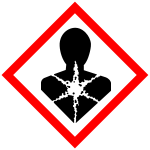Notified classification and labelling according to CLP criteria
General Section
EC / List no.

|
Name |
CAS Number

|
Additional Notified Information

|
|---|---|---|---|
| 200-001-8 | Formaldehyde | 50-00-0 |
State/Form
|
| Classification | Labelling | Specific Concentration limits, M-Factors | Notes |
Classification affected by Impurities / Additives

|
||
|---|---|---|---|---|---|---|
| Hazard Class and Category Code(s) | Hazard Statement Code(s) | Hazard Statement Code(s) | Supplementary Hazard Statement Code(s) | |||
| Acute Tox. 3 | H301 | H301 | Skin Irrit. 2; : 5 % ≤ C < 25 % STOT SE 3; : C ≥ 5 % Skin Corr. 1B; : C ≥ 25 % Eye Irrit. 2; : 5 % ≤ C < 25 % 7546; : C ≥ .2 % |
Note B
Note D |
||
| Acute Tox. 3 | H311 | H311 | ||||
| Skin Corr. 1B | H314 | H314 | ||||
| Skin Sens. 1 | H317 | H317 | ||||
| Acute Tox. 3 | H331 | H331 | ||||
| Carc. 2 | H351 | H351 | ||||
| Signal Words | Pictograms | |||||||||
|---|---|---|---|---|---|---|---|---|---|---|
| Danger |
|
Detailed Information on classification and labelling
Classification
| Physical and Chemical hazards | |||
|---|---|---|---|
| Hazard Category | Hazard Statement |
Reason for no Classification

|
|
| Explosives | data lacking | ||
| Flammable Gases and Chemically Unstable Gases | data lacking | ||
| Flammable Aerosols | data lacking | ||
| Oxidising Gases | data lacking | ||
| Gases Under Pressure | data lacking | ||
| Flammable Liquids | data lacking | ||
| Flammable Solids | data lacking | ||
| Self-reactive Substances and Mixtures | data lacking | ||
| Pyrophoric Liquids | data lacking | ||
| Pyrophoric Solids | data lacking | ||
| Self-heating Substances and Mixtures | data lacking | ||
| Substances and Mixtures which in contact with water emit flammable gases | data lacking | ||
| Oxidising Liquids | data lacking | ||
| Oxidising Solids | data lacking | ||
| Organic Peroxides | data lacking | ||
| Substances and Mixtures corrosive to Metals | data lacking | ||
| Desensitized Explosives | Data lacking | ||
| Human Health hazards | |||
| Hazard Category | Hazard Statement |
Reason for no Classification

|
|
| Acute Toxicity - Oral | Acute Tox. 3 | H301 | |
| Acute Toxicity - Dermal | Acute Tox. 3 | H311 | |
| Acute Toxicity - Inhalation | Acute Tox. 3 | H331 | |
| Skin Corrosion / Irritation | Skin Corr. 1B | H314 | |
| Serious Eye Damage / Eye Irritation | data lacking | ||
| Respiratory Sensitisation | data lacking | ||
| Skin Sensitisation | Skin Sens. 1 | H317 | |
| Aspiration Hazard | data lacking | ||
| Germ Cell Mutagenicity | Hazard Category | Hazard Statement |
Reason for no Classification

|
| Germ Cell Mutagenicity | data lacking | ||
| Carcinogenicity | Hazard Category | Hazard Statement |
Reason for no Classification

|
| Carcinogenicity | Carc. 2 | H351 | |
| Reproductive Toxicity | Hazard Category | Hazard Statement |
Reason for no Classification

|
| Reproductive Toxicity | data lacking | ||
| Effects on or via Lactation | data lacking | ||
| Specific target organ toxicity - Single | Hazard Category | Hazard Statement |
Reason for no Classification

|
| Specific target organ toxicity - Single | data lacking | ||
| Specific target organ toxicity - Repeated | Hazard Category | Hazard Statement |
Reason for no Classification

|
| Specific target organ toxicity - Repeated | data lacking | ||
| Environmental Hazards | |||
| Hazardous to the aquatic environment | Hazard Category | Hazard Statement |
Reason for no Classification

|
| Hazardous to the aquatic environment - acute | data lacking | ||
| Hazardous to the aquatic environment - chronic | data lacking | ||
| Hazardous to the atmospheric environment | Hazard Category | Hazard Statement |
Reason for no Classification

|
| Hazardous to the ozone layer | data lacking | ||
| Additional Hazard Classes | Additional Hazard Statements |
|---|---|
| No available Data | |
Labelling
| Hazard Statement Code(s) | Phrase | Additional Text |
|---|---|---|
| H301 | Toxic if swallowed. | |
| H311 | Toxic in contact with skin. | |
| H314 | Causes severe skin burns and eye damage. | |
| H317 | May cause an allergic skin reaction. | |
| H331 | Toxic if inhaled. | |
| H351 | Suspected of causing cancer |
| Note Title | Note Text |
|---|---|
| Note B | Some substances (acids, bases, etc.) are placed on the market in aqueous solutions at various concentrations and, therefore, these solutions require different classification and labelling since the hazards vary at different concentrations. , In Part 3 entries with Note B have a general designation of the following type: "nitric acid … %". , In this case the supplier must state the percentage concentration of the solution on the label. Unless otherwise stated, it is assumed that the percentage concentration is calculated on a weight/weight basis. |
| Note D | Certain substances which are susceptible to spontaneous polymerisation or decomposition are generally placed on the market in a stabilised form. It is in this form that they are listed in Part 3. , However, such substances are sometimes placed on the market in a non-stabilised form. In this case, the supplier must state on the label the name of the substance followed by the words "non-stabilised". |


